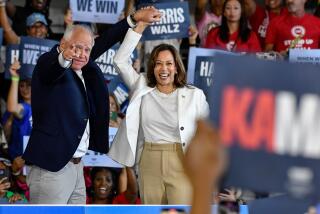Post-Caterpillar, a New UAW Emerges
- Share via
DETROIT — The last time the United Auto Workers tried to force identical labor agreements on competing companies, the union was handed its head in a disastrous strike against Caterpillar Inc., the heavy-equipment maker.
The episode reinforced the image of the once-progressive UAW as hidebound and resistant to change. But the union appears to have learned some lessons.
In the last three months, UAW President Stephen Yokich has drastically changed the traditional tenor and structure of the union’s triennial labor negotiations with Detroit’s Big Three.
No longer is there talk of a “strike target” as the contract approaches its Sept. 14 expiration date. Although the UAW this week named Ford Motor Co. as the company it will focus on as the deadline nears, talks will also continue with General Motors Corp. and Chrysler Corp. Nor will the contract reached at one be rammed down the throats of the others.
“We are doing it a little different,” Yokich said recently. “There is nothing wrong with trying something new. You look at the industry in its total.”
The result has been a more relaxed atmosphere for the normally confrontational talks, as well as prospects for a peaceful resolution. Not that there is any need for saber rattling: The UAW virtually shut down GM’s entire North American production system earlier this year over a local factory dispute, and will again if unexpectedly provoked.
But the changes in the bargaining process are seen by analysts and labor experts as evidence that a significant philosophical shift is occurring within the UAW.
“It’s a real sea change,” said Sean McAlinden, labor economist with the University of Michigan. “This is the most radical change in negotiations with the auto companies that we have seen in 40 years.”
The auto talks provide Yokich a chance to surmount the bitterness of Caterpillar while leaving a more positive legacy for the labor movement. As a leader, he likes to paint in bold strokes and do the unexpected.
Last year, Yokich capitulated in the lengthy strike against Caterpillar, the second major walkout there in four years. The dispute began under his predecessor when the UAW targeted Deere & Co. to negotiate a pattern agreement in 1991 for the farm implements industry--a contract that would be imposed on other UAW-represented companies with few changes.
But when the union took the pattern deal to Caterpillar, the company balked, saying the contract didn’t address its global, competitive needs. Today UAW workers are still without a contract at Caterpillar.
UAW leaders promise the Caterpillar mistake will not happen again. In the auto talks, the union will not seek an across-the-board pattern agreement. In the past, it has insisted on a pattern deal except in times of financial crisis.
“It’s Cat that caused us to backpedal from pattern,” said a top UAW official close to the auto talks.
The contract hammered out with Ford will be taken to Chrysler and GM not as an inflexible document, but as a pliable model that can be molded to fit the needs and problems of each company.
Pattern bargaining has been a basic tenet of negotiations since Walter Reuther led the UAW to a leadership role in the American labor movement. He told the auto makers that they could compete on everything but labor costs.
Yokich says the UAW will still demand uniformity on wages and benefits. But it is likely to be more flexible in negotiating issues such as work rules, job classifications and other provisions related to efficiency.
This approach, industry officials and analysts say, indicates that the UAW understands that the Big Three no longer constitute a monolith and that one company should not be strapped with a contract negotiated by a rival.
“It suggests that the union recognizes that each company is different from the others and each has its strength and weaknesses,” said Maryann Keller, an analyst with Furman Selz Inc.
Each of the Big Three desperately wanted to become this year’s lead bargainer, hoping it could then control its destiny rather than be pressured to accept an agreement fashioned by its cross-town competitor.
GM in particular worries that Ford and Chrysler could be willing to negotiate an agreement that would restrict outsourcing, the practice of contracting work out to nonunion suppliers.
This would be damaging to GM since the auto maker makes more of its parts in-house than do Ford and Chrysler. As a result, its higher wage scales mean GM must pay more for components that outside supply firms could produce for less. GM hopes to send more parts work to outside firms to become more competitive.
There are other reasons the union may be taking a less adversarial approach this year. UAW membership has fallen from 1.5 million to about 750,000 in the last two decades. The union represents about 400,000 auto workers, but more than half of these will retire in the next seven years and not all will be replaced.
If the UAW is to grow in the auto industry, it must look to organize independent auto suppliers. “The UAW cannot make itself as a radical, irrational group if it is to attract new members,” Keller said.
Finally, the union’s members are not eager for a strike. With the auto makers making money, UAW workers are collecting hefty profit-sharing checks--totaling $15,500 per worker at Chrysler in the last three years--and a walkout would eat away at that.






